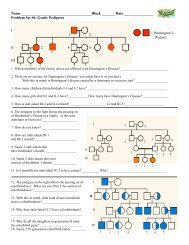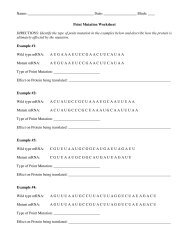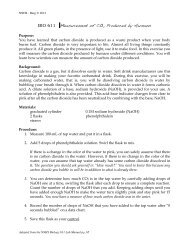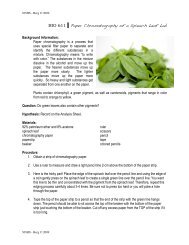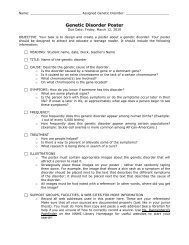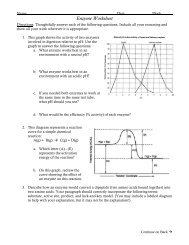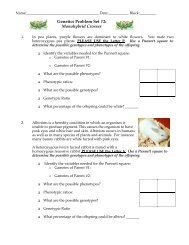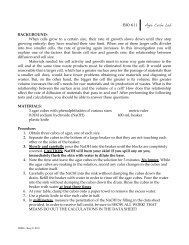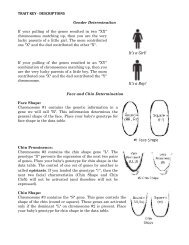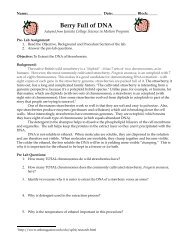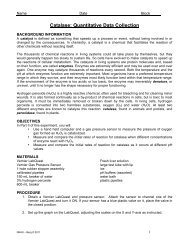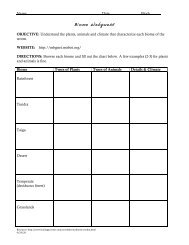LAB_Dragon Lab.10-11 - nnhsbergbio
LAB_Dragon Lab.10-11 - nnhsbergbio
LAB_Dragon Lab.10-11 - nnhsbergbio
You also want an ePaper? Increase the reach of your titles
YUMPU automatically turns print PDFs into web optimized ePapers that Google loves.
<strong>Dragon</strong> Name: ________________________________Name:____________________________________________ Date:___________ Block: ______<strong>Dragon</strong> LabOBJECTIVES:The purpose of this lab is to:(1) Illustrate the processes of transcription and translation.(2) Understand the relationship between a codon, an anticodon, and an amino acid.(3) Determine the phenotype of your dragon based on its DNA sequence.MATERIALS:Copy of the Lab DNA Worksheet <strong>Dragon</strong> TemplatePencil Amino acid chart Colored pencilsPROCEDURE:(1) Look at your DNA Worksheet. There are 8 strands of DNA sequences. Each DNA strandcorresponds to a particular gene, which in turn corresponds to a particular protein that isresponsible for a particular phenotype of a given trait. The traits are: coat color, eye color, fire,tail, horns, wings, teeth and claws.(2) Transcribe the DNA strand into its corresponding messenger RNA (mRNA) strand accordingto the base pairing rules discussed in class. Record your strand on the DNA worksheet.(3) Each triplet of bases on the mRNA strand is called a codon. Every codon has acorresponding anticodon that is found on the transcription RNA (tRNA). We will not writethem out for this lab BUT do not forget they play an important role in the translation process.Please note tRNA helps to bond the correct amino acid to the polypeptide chain.(4) When the tRNA attaches temporarily to the mRNA at the ribosome, it brings with it acorresponding amino acid, which will link together to form a chain. This process is calledtranslation. The chain of amino acids is what creates a protein. Using the amino acid chart,translate the mRNA into a chain of amino acids. (Hint: Look for the start codon. Begintranslation at the start codon and end at the stop codon. You do not need to translate theentire string, just the segment that corresponds to the protein.)(5) The proteins that are produced (or not produced) are what control the phenotype. Using thetrait key on the next page, write the phenotypes of the 8 traits that will be portrayed in yourdragon.(6) Take out your <strong>Dragon</strong> Template. Draw in your phenotypes of your dragon in pencil. Makesure to depict all eight traits.(7) Using markers, crayons, or colored pencils color in your dragon template.(8) Answer the <strong>Dragon</strong> Lab Conclusion Questions.(9) When finished, check over your work. Please staple the DNA Worksheet, <strong>Dragon</strong> LabConclusion Questions and the <strong>Dragon</strong> Template to this paper and submit.
<strong>Dragon</strong> Lab Trait Key<strong>Dragon</strong> Name: ________________________________Trait Amino Acid Chain – Protein PhenotypeCoat Color Met-Phe-Leu-Val-Met Solid coatMet-Phe-Phe-Val-MetSpotted coatEye Color Met-Ser-Asn-Val-Arg Blue eyesMet-Ser-Val-ArgGreen eyesMet-Asn-Asn-Val-ArgRed eyesFire Met-Pro-Leu-Gly-Gln Yellow FireMet-Pro-Leu-Ala-GlnBlue FireNo ProteinNo FireTail Met-Pro-Thr-Asn-Glu-Ala Spiked TailNo ProteinNo spikes on TailHorns Met-Val-Gly-His-Gln Double HornsMet-Val-Gly-Trp-His-GlnSingle HornsNo ProteinHornlessWings Met-Gly-Arg-Gln-Asp 2 pairs of WingsMet-Arg-Gln-Asp1 pair of WingsNo ProteinWinglessClaws Met-Lys-Tyr-Arg-Thr Long ClawsMet-Lys-Phe-Arg-ThrShort ClawsTeeth Met-Phe-Asn-Glu-Arg-Leu-His-Pro Short, Square Front TeethMet-Leu-Asp-Glu-Arg-Leu-His-Pro Long, Sharp Front Teeth
<strong>Dragon</strong> Name: ________________________________




